Quiz Summary
0 of 40 Questions completed
Questions:
Information
You have already completed the quiz before. Hence you can not start it again.
Quiz is loading…
You must sign in or sign up to start the quiz.
You must first complete the following:
Results
Results
0 of 40 Questions answered correctly
Your time:
Time has elapsed
You have reached 0 of 0 point(s), (0)
Earned Point(s): 0 of 0, (0)
0 Essay(s) Pending (Possible Point(s): 0)
| Average score |
|
| Your score |
|
Categories
- UWSA CK 1 BLOCK 3 0%
| Pos. | Name | Entered on | Points | Result |
|---|---|---|---|---|
| Table is loading | ||||
| No data available | ||||
- 1
- 2
- 3
- 4
- 5
- 6
- 7
- 8
- 9
- 10
- 11
- 12
- 13
- 14
- 15
- 16
- 17
- 18
- 19
- 20
- 21
- 22
- 23
- 24
- 25
- 26
- 27
- 28
- 29
- 30
- 31
- 32
- 33
- 34
- 35
- 36
- 37
- 38
- 39
- 40
- Current
- Review
- Answered
- Correct
- Incorrect
-
Question 1 of 40
1. Question
A 31-year-old woman has been experiencing exertional shortness of breath and chest tightness over the last several months. She was previously able to run several miles at a time but now is limited by the symptoms. The patient weighs 60 kg (132.3 lb) and is 162.5 cm (5′ 4″) tall; BMI is 22.7 kg/m2. Respirations are 22/min. Physical examination shows a right ventricular heave on chest palpation and bilateral pitting edema of the ankles. ECG reveals evidence of right ventricular hypertrophy. Which of the following is the most likely cause of this patient’s condition?
CorrectIncorrect -
Question 2 of 40
2. Question
A 32-year-old woman comes to the office for follow-up for heavy menses, which have become heavier and longer over the last year. The patient now soaks 6 heavy pads during each of the first several days and occasionally passes clots. Menarche occurred at age 11; menses start predictably every 28-30 days and last 10 days. At the end of her last menses, the patient received a blood transfusion in the emergency department. She takes no medications and has no allergies. The patient uses no contraception because she has been trying to conceive for a year. Bimanual pelvic examination reveals an irregularly enlarged uterus. Laboratory results are as follows:
Hemoglobin
8.2 g/dL
Leukocytes
4,600/mm3
Platelets
170,000/mm3
Which of the following is the most likely diagnosis in this patient?
CorrectIncorrect -
Question 3 of 40
3. Question
A 64-year-old man complains of crampy abdominal pain while passing stool over the last two days. He has also noticed some blood in his stool. He denies vomiting, fever or urinary symptoms. He experienced myocardial infarction six years ago. Physical examination reveals decreased bowel sounds. The right femoral and dorsalis pedis pulses are weak. Colonoscopy visualizing the rectum, sigmoid colon and a portion of the descending colon is performed. Which of the following findings are most likely in this patient?
CorrectIncorrect -
Question 4 of 40
4. Question
A 20-year-old woman is referred to the clinic due to low bone mineral density found on ultrasound screening during a health fair sponsored by her employer. She has no other medical problems and takes no medications. The patient is an avid cyclist and goes on long rides several times a week. She eats a varied diet that includes adequate amounts of dairy products and vegetables. Physical examination shows mild scoliosis. Ophthalmologic examination shows thin sclerae with visibility of the underlying choroid layers. Dual-energy x-ray absorptiometry is diagnostic for osteoporosis. Which of the following proteins is most likely improperly synthesized in this patient?
CorrectIncorrect -
Question 5 of 40
5. Question
A 2-year-old previously healthy boy is brought to the hospital due to several episodes of vomiting and lethargy. His mother reports that he started having a low-grade fever and runny nose 2 days ago and has since been not eating well. The patient’s immunizations are up to date, but newborn screening for metabolic disorders was not performed. While being evaluated in the emergency department, he has a brief, generalized tonic-clonic seizure. Temperature is 37.2 C (99 F), and other vital signs are stable. Physical examination shows mild hepatomegaly. Laboratory evaluation shows blood glucose of 40 mg/dL and low blood ketone levels. Which of the following enzymes is most likely deficient in this patient?
CorrectIncorrect -
Question 6 of 40
6. Question
A 53-year-old woman is diagnosed with a metastatic brain tumor after developing new-onset, generalized tonic-clonic seizures. Several of her family members also have a history of cancer. The location of the primary tumor is determined and appropriate management is initiated. Further studies reveal that this patient is predisposed to malignancy as a result of a genetic alteration in a protein that functions to transduce signals from the cell membrane to the nucleus by activating other molecules. Which of the following proteins is most likely defective in this patient?
CorrectIncorrect -
Question 7 of 40
7. Question
A 68-year-old man on warfarin therapy after a mechanical valve replacement develops a rapid decrease in INR after starting rifampin. Rifampin induces synthesis of CYP2C9, a cytochrome P450 enzyme in hepatocytes, leading to increased warfarin metabolism. Which of the following plots most likely represents the change in CYP2C9 enzyme kinetics with regard to warfarin metabolism? (Solid line, original state; dashed line, change in kinetics)
A.

B.

C.

D.

E.
 CorrectIncorrect
CorrectIncorrect -
Question 8 of 40
8. Question
A 75-year-old man comes to the clinic due to knee pain that restricts his daily activities. The pain is worse in the latter half of the day. His symptoms began a year ago and have worsened progressively. The patient’s father had a similar problem before his death. The family has always lived in a cold climate and enjoys an active lifestyle, including snowshoeing and cross-country skiing. Past medical history is notable for hypertension and coronary artery disease, which required percutaneous revascularization 3 years ago. The patient smoked a half-pack of cigarettes daily for 40 years, but quit when he was diagnosed with heart disease. An x-ray of the knees is shown in the image below.

Which of the following is the most significant risk factor for this patient’s condition?
CorrectIncorrect -
Question 9 of 40
9. Question
A 34-year-old man comes to the emergency department after coughing up approximately 2 tablespoons of bright-red blood. The patient reports a nonproductive cough but no fever, chills, night sweats, chest pain, or shortness of breath. He has had 2 episodes of pneumonia involving the left lung over the past 6 months but has no other medical conditions and no history of exposure to tuberculosis. The patient does not use tobacco, alcohol, or illicit drugs. Temperature is 37.1 C (98.8 F), blood pressure is 130/70 mm Hg, and pulse is 80/min. Physical examination reveals left-sided wheezing and rhonchi. CT scan of the chest reveals an endobronchial mass in the left mainstem bronchus with no focal parenchymal opacities or lymphadenopathy. Biopsy of the mass demonstrates uniform, polygonal cells containing eosinophilic cytoplasm and granular nuclear chromatin. Immunohistochemical staining is positive for chromogranin and synaptophysin. This patient’s tumor is most likely to secrete which of the following substances?
CorrectIncorrect -
Question 10 of 40
10. Question
An organism is isolated from a sample taken from a 26-year-old patient with an underlying infection. Laboratory analysis shows that the organism has the following characteristics:
Genome
Haploid
Inner membrane
Present
Outer membrane
Present
Nuclear membrane
Absent
Antibiotic susceptibility is performed by disk diffusion on standard culture media. The organism is found to be sensitive to some, but not all, penicillin antibiotics. Based on these data, which of the following organisms was most likely isolated from this patient?
CorrectIncorrect -
Question 11 of 40
11. Question
A researcher is studying different cellular events that occur during apoptosis. Experimental results show that activated caspases degrade several intracellular proteins, including translation initiation factors. One of these factors, eIF4, initiates translation by recognizing and binding the 5′ cap of mRNA. Although the cells under investigation are dying, they continue to synthesize many proteins required for apoptosis. This observation can be best explained by which of the following features of mRNA?
CorrectIncorrect -
Question 12 of 40
12. Question
A 46-year-old woman with type 2 diabetes mellitus comes to the clinic for a follow-up appointment. She was diagnosed with diabetes 5 years ago and has been treated with metformin. Over the last year, her glycemic control has worsened despite good compliance with diet, exercise, and medication. Laboratory results show a fasting glucose level of 185 mg/dL and hemoglobin A1c of 8.0%. After discussing medication options, the patient agrees to the addition of an oral antidiabetic medication that induces differentiation of preadipocytes into adipocytes and increases glucose transporter-4 expression on the adipocyte cell membrane. Which of the following agents was most likely chosen for this patient?
CorrectIncorrect -
Question 13 of 40
13. Question
A 23-year-old woman suffering from chronic diarrhea is evaluated for drainage of an abscess. The patient has malaise and significant pain originating from the site. The pain is constant and graded 8/10 in intensity. Her temperature is 38.3 C (101 F), blood pressure is 125/85 mm Hg, and pulse is 92/min. Physical examination reveals mouth ulcers and an area of fluctuance with overlying erythema near the perineum. There is no arthritis or skin rash. Biopsy of which of the following areas will be the most helpful for diagnosing this patient’s underlying condition?
CorrectIncorrect -
Question 14 of 40
14. Question
A 55-year-old woman is started on oral fluconazole therapy for recurrent vaginal candidiasis. She has a history of poorly controlled diabetes mellitus and has had 4 episodes of vaginal candidiasis within the past year that were treated with topical antifungals. Her only other medical problem includes mechanical mitral valve replacement, for which she takes daily warfarin. Which of the following changes in the prothrombin time (PT) is most likely seen after antimycotic therapy is started in this patient?
 CorrectIncorrect
CorrectIncorrect -
Question 15 of 40
15. Question
A 37-year-old man is brought to the hospital due to confusion and sleep disturbances. The patient’s wife reports that he has become progressively disoriented over the past week. He has difficulty sleeping at night and is often drowsy during the day. The patient has a history of intravenous drug use. Physical examination reveals yellow sclerae, abdominal distension with a positive fluid wave test, and ankle edema. Jerky, involuntary hand movements are also seen with dorsiflexion. Laboratory results are as follows:
Hepatitis A immunoglobulin M
negative
Hepatitis A immunoglobulin G
positive
Hepatitis B surface antigen
positive
Hepatitis B surface antibody
negative
Hepatitis C virus antibody
positive
Which of the following is most likely to improve this patient’s confusion?
CorrectIncorrect -
Question 16 of 40
16. Question
A 64-year-old man comes to the office with 2 days of fever, chills, dysuria, and perineal pain. Medical history reveals hypertension, benign prostatic hyperplasia, and atrial fibrillation for which he takes warfarin for anticoagulation. Physical examination shows an edematous, exquisitely tender prostate. Based on urine culture results, the patient is prescribed trimethoprim-sulfamethoxazole for acute bacterial prostatitis. His warfarin dose is adjusted to maintain a therapeutic INR range of 2.0-3.0. The patient’s symptoms improve rapidly. On completion of the 6-week course of antibiotic therapy, the warfarin dosage is not adjusted; at the 8-week follow-up appointment, his INR is 1.2. Which of the following best explains the need to adjust this patient’s warfarin dosage prior to starting antibiotics?
CorrectIncorrect -
Question 17 of 40
17. Question
A 25-year-old woman comes to the emergency department due to difficulty breathing for the past hour. She has experienced episodic chest tightness since moving to a new house in the country 2 months ago. The patient has no prior medical conditions and takes no medications. Temperature is 36.7 C (98 F), blood pressure is 130/80 mm Hg, pulse is 100/min, and respirations are 22/min. On physical examination, there is prolonged expiration and scattered expiratory wheezes bilaterally. Several minutes after appropriate treatment is administered the patient begins to feel better. This treatment most likely improved this patient’s symptoms by increasing the intracellular concentration of which of the following substances?
CorrectIncorrect -
Question 18 of 40
18. Question
A 76-year-old man comes to the clinic with diffuse lower extremity bone pain and weakness. His symptoms began 2 months ago and have progressively worsened. The patient has resided in an assisted living facility since his wife passed away a year ago. He prepares his own meals, which consist primarily of prepackaged processed foods. He spends little time outdoors and prefers to watch television or play games with his neighbors. On examination, he has tenderness to firm palpation at the tibia bilaterally. Neurologic examination is normal. This patient most likely has impaired mineralization of which of the following bone components?
CorrectIncorrect -
Question 19 of 40
19. Question
A 64-year-old army veteran comes to the office due to a 3-month history of cramping pain in the right calf that has gradually worsened. The pain is worse when he walks and is now occasionally present at rest. In addition, the pain is often worse at night, and interferes with sleep unless he sleeps in a chair. Past medical history is notable for type 2 diabetes mellitus diagnosed 15 years ago. Physical examination shows thinning of the skin at the right foot, with a small ulcer at the tip of the right second toe. Which of the following is the most likely cause of this patient’s symptoms?
CorrectIncorrect -
Question 20 of 40
20. Question
A healthy 21-year-old woman comes to the physician concerned about her risk of developing cancer. She has a strong family history of early-onset breast cancer and soft tissue sarcomas. The physician strongly suspects a familial history of Li-Fraumeni syndrome. If she has inherited this condition, germline DNA analysis would most likely demonstrate which of the following genetic abnormalities?
CorrectIncorrect -
Question 21 of 40
21. Question
A 36-year-old woman comes to the office due to insomnia. The patient describes having difficulty falling asleep approximately 3 times a week for the past few months. She says, “This is definitely a change. I’ve never had concerns about sleep before.” She has no medical history and takes melatonin as needed. The patient moved to the area a year ago following a divorce and works as a school aide. She mentions that being a single parent is extremely difficult. She becomes tearful as she describes a recent incident with her 13-year-old daughter. The patient says, “After we argued about her staying out late, she accused me of ruining her life and didn’t speak to me for 3 days. I’ve been trying so hard to make everything right since we moved here.” Which of the following responses by the physician is most appropriate?
CorrectIncorrect -
Question 22 of 40
22. Question
A 65-year-old man is evaluated in the clinic due to hoarseness for the past 2 weeks. The patient has no associated fever, nasal congestion, sore throat, cough, regurgitation, or heartburn. He cheered loudly during his grandson’s soccer game last month but has not strained his voice since. His past medical history is significant for hypertension, type 2 diabetes mellitus, and hyperlipidemia. He also underwent coronary artery stenting 2 years ago following an episode of chest pain. The patient does not use alcohol or tobacco. Chest CT scan reveals dilation of the aortic arch. Which of the following additional findings is most likely to be seen in this patient?
CorrectIncorrect -
Question 23 of 40
23. Question
A virus is isolated from an epithelial tissue sample of a 38-year-old woman. Analysis shows that the virus replicates in the nucleus using host enzymes. The infecting virus most likely belongs to which of the following families?
CorrectIncorrect -
Question 24 of 40
24. Question
A 43-year-old man comes to the emergency department due to low-grade fevers, chest pain, and a cough productive of blood-streaked sputum. He also developed a skin rash on his arms and symmetric joint pains within the past few days. The patient is a sales representative who recently traveled to Mexico and South America for business. He has no significant medical history and has never been hospitalized. He smokes a pack of cigarettes daily and consumes alcohol only occasionally. Chest x-ray reveals a thin-walled cavity in the right middle lobe. Which of the following organisms is most likely responsible for this patient’s symptoms?
CorrectIncorrect -
Question 25 of 40
25. Question
A 35-year-old, previously healthy woman comes to the office due to a painless mass in her neck that has been progressively enlarging over the past several months. In addition, her sleep is often disturbed, and she feels tired all the time. Medical history is unremarkable. The patient works as a radiation technician and has remained current with occupational safety training and radiation exposure monitoring. She does not use tobacco, alcohol, or recreational drugs. Physical examination shows a diffusely enlarged, firm thyroid gland. The findings from a thyroid biopsy are shown in the image below:

Which of the following is the most likely diagnosis?
CorrectIncorrect -
Question 26 of 40
26. Question
A young patient is evaluated for poor exercise tolerance. PO2 readings from different compartments of the cardiovascular system are given below.
Superior vena cava
43 mm Hg
Pulmonary veins
98 mm Hg
Right atrium
65 mm Hg
Left atrium
97 mm Hg
Right ventricle
65 mm Hg
Left ventricle
97 mm Hg
Pulmonary artery
65 mm Hg
Ascending aorta
97 mm Hg
Descending aorta
97 mm Hg
The patient most likely has which of the following findings on physical examination?
CorrectIncorrect -
Question 27 of 40
27. Question
A 29-year-old woman, gravida 2 para 1, comes to the office for a prenatal evaluation. She feels fine and examination is unremarkable. Recent ultrasound revealed a normal-appearing single male fetus. The patient says that her older son started crawling at age 6 months and walked at age 11 months. However, at age 4, he started having difficulty ambulating on his own and now struggles to rise from the floor without “walking” his hands up his body. Family pedigree for the disorder is shown below, with the patient marked by the arrow and her unborn son marked with a ‘P’.

The patient asks what the chances are of her unborn child suffering from the same disease. Given the information in the pedigree, which of the following is the best response?
CorrectIncorrect -
Question 28 of 40
28. Question
A 65-year-old man undergoes a colonoscopy that reveals a suspicious lesion. Tissue biopsy confirms a diagnosis of adenocarcinoma of the colon. The patient appears visibly upset on hearing the diagnosis but quickly regains his composure. At dinner that night, he describes to family members the different stages of colon cancer and the various treatments available. The patient reassures them that he has learned about the disease and knows what to expect. His wife remarks that he talks “as if he is discussing someone else’s illness.” Which of the following defense mechanisms best explains the patient’s behavior?
CorrectIncorrect -
Question 29 of 40
29. Question
A 40-year-old man comes to the office due to food “sticking” in his throat. He has also had cough, nocturnal regurgitation, and difficulty belching. The patient has no other medical problems and takes no medications. He has a 20-pack-year smoking history and occasionally drinks beer. Vital signs are normal. Examination shows no palpable neck masses. The trachea is midline. The oropharynx is clear. The lungs are clear to auscultation and percussion. Heart sounds are normal. The abdomen is soft and nontender with no organomegaly. Barium study findings are shown below.

Which of the following is the most likely cause of this patient’s symptoms?
CorrectIncorrect -
Question 30 of 40
30. Question
A 25-year-old woman comes to the office due to jaundice. She first noticed mild yellowing of her eyes yesterday and noticed her skin had a yellow tinge today. The patient recently began taking nitrofurantoin for treatment of uncomplicated cystitis. Temperature is 37.1 C (98.8 F), blood pressure is 128/80 mm Hg, and pulse is 116/min. Scleral icterus and mucous membrane pallor are noted on physical examination. The skin is jaundiced. Lungs are clear bilaterally, and cardiac examination is notable for mild tachycardia. The abdomen is nontender, and there is no organomegaly. Laboratory results are as follows:
Hemoglobin
8 g/dL
Reticulocytes
10%
Total bilirubin
3.4 mg/dL
Direct bilirubin
0.6 mg/dL
Peripheral smear reveals blister and bite cells. Which of the following is the most likely cause of this patient’s current condition?
CorrectIncorrect -
Question 31 of 40
31. Question
A 63-year-old man is brought to the emergency room due to acute-onset neurologic deficits. The patient’s symptoms started shortly after waking up this morning. He has a history of hypertension and hyperlipidemia, and has smoked a pack of cigarettes daily for the past 40 years. His father had a stroke at age 60. Neuroimaging shows an infarction involving the territory marked by the asterisk in the image below.

Which of the following findings is most likely present on this patient’s neurologic examination?
CorrectIncorrect -
Question 32 of 40
32. Question
A 31-year-old man comes to the emergency department due to fever, dysuria, urinary frequency, and pelvic pain. His symptoms began a week ago and have become progressively worse. The patient has no associated genital lesions or urethral discharge. He has a history of HIV and is on appropriate antiretroviral therapy. His temperature is 38.8 C (102 F), blood pressure is 135/85 mm Hg, and pulse is 96/min. Abdominal examination is unremarkable. There is exquisite tenderness anteriorly on digital rectal examination. Laboratory evaluation shows leukocytosis. A transverse T1-weighted MRI image of the pelvis is shown below. Which of the following is the most likely site of infection in this patient?
 CorrectIncorrect
CorrectIncorrect -
Question 33 of 40
33. Question
In animal experiments, the effects of various substances on the glomerular filtration rate (GFR) and renal plasma flow (RPF) are studied. Mean arterial pressure (MAP) is kept constant. In the figures below, convergent arrowheads represent arteriolar constriction, while divergent arrowheads represent arteriolar dilation. Which of the following figures signifies an increase in GFR and a decrease in RPF?
A.
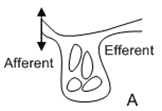
B.
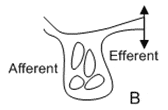
C.
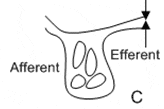
D.
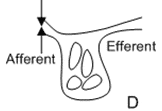
E.
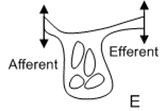 CorrectIncorrect
CorrectIncorrect -
Question 34 of 40
34. Question
During an experiment, a researcher cuts unmyelinated nerve fibers. These fibers are most likely a component of which of the following?
CorrectIncorrect -
Question 35 of 40
35. Question
A 23-year-old woman tells her therapist that she and her boyfriend have developed a deeper level of bonding over the past several months due to her adopting his belief that God has chosen him to carry out a special mission. She says that he is the new messiah and is destined to save the world by writing a manuscript that will help spread his wisdom to others. She denies auditory and visual hallucinations. The patient lives with her boyfriend and works part-time as a substitute teacher at a local high school. Family history is significant for a brother with bipolar disorder. Which of the following is the most likely diagnosis?
CorrectIncorrect -
Question 36 of 40
36. Question
Two groups of investigators are studying the epidemiology of tuberculosis in rural Nepal. The first group uses a sample of 1,000 rural residents and the second group uses a sample of 5,000 rural residents. Compared to the first group, the second group is likely to report a lower:
CorrectIncorrect -
Question 37 of 40
37. Question
An 8-year-old boy is brought to the emergency department due to 2 days of worsening headaches, vomiting, and fever. He has not had diarrhea. The boy is alert and communicative but cries when the lights are turned on in the examination room. His temperature is 39.2 C (102.6 F). Lumbar puncture is performed and a cerebrospinal fluid sample is sent for analysis. Bacterial cultures are sterile, but polymerase chain reaction testing of his cerebrospinal fluid reveals a positive-sense, single-stranded RNA virus. This virus is most likely to belong to which of the following families?
CorrectIncorrect -
Question 38 of 40
38. Question
A researcher is studying macrophage antigen presentation to CD4+ T lymphocytes. Which of the following is a major histocompatibility complex class II component that is digested by macrophages during antigen processing?
CorrectIncorrect -
Question 39 of 40
39. Question
A 62-year-old woman comes to the office due to a few months of progressive dryness and pain along the corner of her lips. She has been applying a moisturizing ointment, but her lips have become more red and painful. The patient has also had difficulty swallowing large pieces of solid food due to a sensation that food is getting stuck in her throat. She takes no medications. BMI is 20 kg/m2. Examination shows mucosal pallor. The corners of her mouth are cracked and erythematous. The tongue appears smooth and red. The lungs are clear bilaterally. The abdomen is nontender. Skin examination shows no bleeding or bruising. One of her nails is shown in the below image.

Supplementation with which of the following is most likely to improve this patient’s condition?
CorrectIncorrect -
Question 40 of 40
40. Question
A 43-year-old woman who has fasted for 10 hours ingests 75 g of glucose at the time indicated by the red arrow below. The graph tracks her blood glucose and insulin levels afterward.
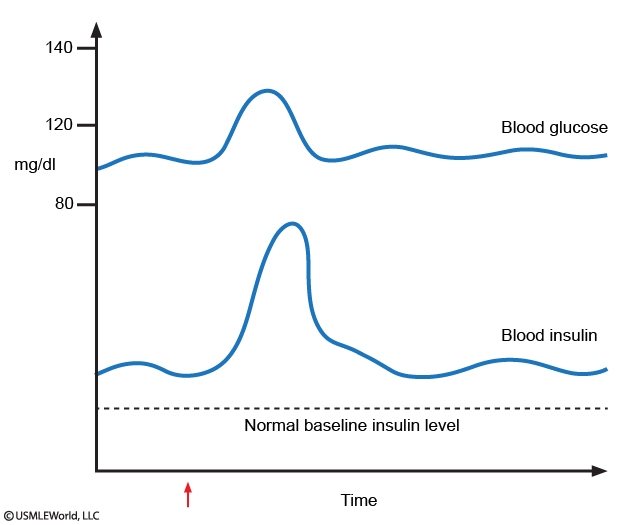
Which of the following pathophysiologic changes is the best explanation for the observed findings?
CorrectIncorrect
